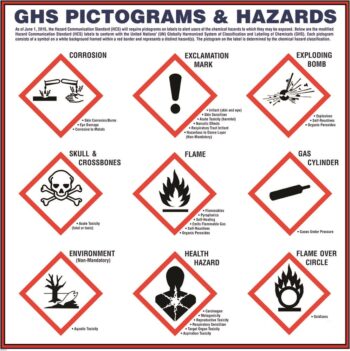WHAT IS GHS ?
Globally Harmonized System (GHS)
What is the Globally Harmonized System (GHS)?
GHS stands for the Globally Harmonized System of Classification and Labelling of Chemicals. It is a
system of hazard communication for chemical hazards that can be adopted by countries around the
world. GHS was developed by a United Nations (UN) international team of hazard communication
experts. They established the following two major standardized elements:
1. rules for classifying the hazards of chemical products (i.e., substances, materials, or
mixtures)
2. hazard communication tools such as:
o format for safety data sheets (SDSs),
o content for label and SDSs with
▪ hazard and precautionary statements
▪ symbols
▪ signal word
Why was GHS developed?
GHS was developed because many different countries had different systems for classification and
labelling of chemical products. In addition, several different systems can exist even within the
same country.
While existing systems were similar in many respects, their differences were significant enough to
result in different hazard classifications, labels, or SDS for the same product. For example, one
country may classify a product as carcinogenic while another country will not.
This situation has been expensive for governments to regulate and enforce, costly for companies who
have to comply with many different systems, and confusing for workers who need to understand the
hazards of a chemical in order to work safely.
As more and more countries adopt the principles of GHS, the benefits include:
• Promoting regulatory efficiency.
• Facilitating trade.
• Easing compliance.
• Reducing costs.
• Providing improved, consistent hazard information.
• Encouraging the safe transport, handling and use of chemicals.
• Promoting better emergency response to chemical incidents.
• Reducing the need for animal testing.
What is the scope of GHS?
GHS covers all hazardous chemicals products, such as those used for the following purposes:
o industrial chemicals
o consumer chemical products
o pesticides
o agricultural chemicals
o pharmaceuticals
The target audiences for GHS include workers in many different industries (e.g., warehouses,
construction, chemical manufacturing, transportation), emergency responders, and consumers.
United States (USA)
United States adopted the GHS elements from the 3rd revised edition of the GHS purple book in their
Hazardous Communication Standard (HCS) in 2012. This standard is commonly referred to as HCS 2012
and is currently in full force. OSHA is conducting rulemaking to harmonize the HCS to the latest
edition of the GHS and to codify a number of enforcement policies that have been issued since the
2012 standard. In their “OSHA Trade Release”, OSHA announced that they are issuing a proposed rule
to update the HCS 2012 with the 7th revised edition of the GHS purple book.
Check regulatory updates at:
• OSHA Trade
Release https://www.osha.gov/news/newsreleases/trade/02052021 Information and resources for the
current US HCS 2012 standard is available at:
• Hazard communication https://www.osha.gov/hazcom
What are some key terms in the GHS Vocabulary?
• SDS – Safety Data Sheet. The GHS SDS has 16 sections in a set order, and minimum information is
prescribed.
• Labels - With the GHS, certain information will appear on the label. Standardized elements such
as chemical identify, hazard statements, signal words and symbols will appear on the label
according to the classification of that chemical or mixture. Precautionary statements may also be
required, if adopted by your regulatory authority.
• Hazard group – While not given a formal definition, GHS divides hazards into three major groups
– health, physical and environmental.
• Class – Class is the term used to describe the different types of hazards. For example, Gases
under Pressure is an example of a class in the physical hazards group.
• Category – Category is the name used to describe the sub-sections of classes. For example,
Self-Reactive Chemicals have 7 categories. Each category has rules or criteria to determine what
chemicals are assigned to that category. Categories are assigned numbers (or letters) with category
1 (or A) being the most hazardous.
• Hazard Statement – For each category of a class, a standardized statement is used to describe
the hazard. For example, the hazard statement for chemicals which meet the criteria for the class
Self-heating substances and mixtures, Category 1 is Self-heating; may catch fire. This hazard
statement would appear both on the label and on the SDS.
• Precautionary Statement – These statements are standardized phrases that describe the
recommended steps to be taken to minimize or prevent adverse effects from exposure to or resulting
from improper handling or storage of a hazardous product.
• Signal word – There are two signal words used by the GHS – Danger and Warning. These signal
words are used to communicate the level of hazard on both the label and the SDS. The appropriate
signal word to use is set out by the classification system. For example, the signal word for
Self-heating substances and mixtures, Category 1 is Danger while Warning is used for the less
serious Category 2. There are categories where no signal word is used.
• Pictogram – Pictogram – Pictogram refers to the GHS symbol on the label and SDS. Not all
categories have a pictogram associated with them.
What are the classes within the Health hazard group?
Criteria for classifying chemicals have been developed for the following health hazard classes:
• Acute toxicity.
• Skin corrosion/irritation.
• Serious eye damage/eye irritation.
• Respiratory or skin sensitization.
• Germ cell mutagenicity.
• Carcinogenicity.
• Reproductive toxicity.
• Specific target organ toxicity - single exposure.
• Specific target organ toxicity - repeated exposure.
• Aspiration hazard.

